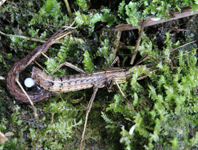Abstract
The fossorial snake genus Anomalepis Jan 1860 currently comprises four species with distribution restricted to the Neotropics, occurring from Nicaragua to trans-Andean Peru. Species of Anomalepis occur on the mainland from sea level to about 2,700 m elevation in habitats that range from xerophyte vegetation to tropical wet forests (Kofron 1988; McDiarmid et al. 1999; Uetz et al. 2019; Wallach et al. 2014). Kofron (1988) performed a taxonomic review of the genus Anomalepis, recognizing two phenotypic clusters of species: the A. mexicanus Jan 1860 composed exclusively by its nominal form, and the A. aspinosus Taylor 1939 group consisting of the former species, A. colombia Marx 1953 (Fig. 1) and A. flavapices Peters 1957. While Anomalepis aspinosus occurs in xerophytic formation from 500–2700 above sea level (asl hereafter) along the Peruvian Andes (Kofron 1988; McDiarmid et al. 1999; Wallach et al. 2014), and Anomalepis flavapices is found in the coastal rainforest plains of northwestern Ecuador (Kofron 1988; Wallach et al. 2014), Anomalepis mexicanus presents the most widespread distribution amongst its congeners, occurring in northeastern Honduras, Nicaragua, Costa Rica and Panama from sea level to 725 m altitude. Even though this species has previously been recorded for Peru (Kofron, 1988), it seems unlikely that this specimen belongs to A. mexicanus due to its distinct meristic features (see Kofron 1988) and its outlandish record (see Fig. 2). Marx (1953) described Anomalepis colombia based on a single specimen collected in 1946 by Kjell von Sneidern at La Selva (05º25’23N, 74º57’44W; 1700 m asl), municipality of Pueblo Rico, department of Caldas, Colombia. As far as we know, since its original description, no additional specimen of A. colombia has been reported in literature (cf. Kofron 1988; McDiarmid et al. 1999; Wallach et al. 2014).
References
Hansen, M.C., Potapov, P.V., Moore, R., Hancher, M., Turubanova, S.A., Tyukavina, A., Thau, D.S., Stehman, V., Goetz, S.J., Loveland, T.R., Kommareddy, A., Egorov, A., Chini, L., Justice, C.O. & Townshend, J.R.G. (2013) High-resolution global maps of 21st-Century forest cover change. Science, 342, 850–53.
https://doi.org/10.1126/science.1244693
Jan, G. (1860) Iconographie Générale des Ophidiens. 1. Livraison. J.B. Bailière et Fils, Paris, 6 pls.
Kofron, C.P. (1988) The central and South American blindsnakes of the genus Anomalepis. Amphibia-Reptilia, 9, 7–14.
https://doi.org/10.1163/156853888X00152
Marín-Gómez, O.H. (2005) Avifauna del campus de la Universidad del Quindío. Boletín SAO, 15 (2), 42–60.
Marx, H. (1953) A new worm snake from Colombia genus Anomalepis. Chicago Natural History Museum, 34 (17), 197–198.
https://doi.org/10.5962/bhl.title.2876
McDiarmid, R.W., Campbell, J.A. & Touré, T.S.A. (1999) Snake Species of the World: A Taxonomic and Geographic Reference. Vol. 1. Herpetologists’ League, Washington D.C., 511 pp.
Peters, J.A. (1957) Taxonomic Notes on Ecuadorian Snakes in the American Museum of Natural History. American Museum Novitates, 1851, 1–13.
Savage, J. M. (2002) The Amphibians and Reptiles of Costa Rica: A Herpetofauna between Two Continents, between Two Seas. The University of Chicago Press, Chicago, 934 pp.
Sabaj, M.H. (2016) Standard Symbolic Codes for Institutional Resource Collections in Herpetology and Ichthyology: An Online Reference. Version 6.5. American Society of Ichthyologists and Herpetologists, Washington, D.C. Available from: http://www.asih.org/standardsymbolic-codes (accessed 26 April 2019)
Taylor, E.H. (1939) Two new species of the genus Anomalepis Jan, with a proposal of a new family of snakes. Proceedings of the New England Zoological Society, 17, 87–96.
Uetz, P. & Hošek, J. (2014) The Reptile Database. Available from: http://www.reptile-database.org (accessed 8 January 2014)
Vanegas-Guerrero, J., Mantilla-Castaño, J.C. & Passos, P. (2014) Atractus titanicus Passos, Arredondo, Fernandes & Lynch, 2009 (Serpentes: Dipsadidae): filling gaps in its geographical distribution. Check List, 10 (3), 672–673.
http://doi.org/10.15560/10.3.672
Vásquez-V., V.H. & Serrano-G., M.A. (2009) Las Áreas Naturales Protegidas de Colombia. Panamericana Formas e Impresos, Bogotá D.C., 696 pp.
Wallach, V., Williams, K.L. & Boundy, J. (2014) Snakes of the World: A Catalogue of Living and Extinct Species. CRC Press, Boca Raton, 1237 pp.
https://doi.org/10.1201/b16901

